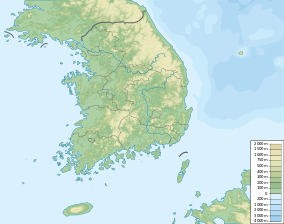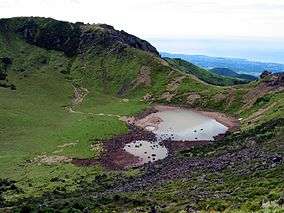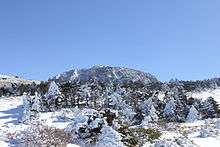Hallasan
| Hallasan | |
|---|---|
 View of Hallasan from the south. | |
| Highest point | |
| Elevation | 1,950 m (6,400 ft) [1] |
| Prominence | 1,950 m (6,400 ft) [1] |
| Listing |
Country high point Ultra |
| Coordinates | 33°21′42″N 126°31′45″E / 33.36167°N 126.52917°ECoordinates: 33°21′42″N 126°31′45″E / 33.36167°N 126.52917°E [2] |
| Geography | |
 Hallasan South Korea | |
| Location | Jeju-do, South Korea |
| Geology | |
| Mountain type | Shield volcano |
| Last eruption | 1007 A.D. |
| Climbing | |
| Easiest route | trails, helicopter |
| Korean name | |
| Hangul | 한라산 (North: 한나산) |
|---|---|
| Hanja | 漢拏山 |
| Revised Romanization | Hallasan |
| McCune–Reischauer | Hallasan |
Hallasan is a shield volcano on Jeju Island of South Korea. Hallasan is the highest mountain in South Korea. The area around the mountain is a designated national park, the Hallasan National Park (Hallasan Gungnip Gongwon/한라산국립공원/漢拏山國立公園). Hallasan is commonly considered to be one of the three main mountains of South Korea, with Jirisan and Seoraksan being the other two.
Names
Mount Hallasan is the highest mountain in South Korea and is worshiped by people because they think that gods and spirits live on it. Alternate English names for the mountain include Hanla Mountain or Mount Halla and older English sources refer to the peak as Mount Auckland.[3][4] Hallasan is written in North Korea in Chosungul as if it were Hannasan (한나산); however, it is still pronounced as Hallasan. In the past, Hallasan has been known by numerous other names in Korean including Buak (부악/釜岳), Wonsan (원산/圓山), Jinsan (진산/鎭山), Seonsan (선산/仙山), Dumuak (두무악/頭無岳), Burasan (부라산/浮羅山), Yeongjusan 영주산(瀛州山), and Hyeolmangbong (혈망봉/穴望峯).[5] Every name son Hallasan have meanings and legends.
Hallasan
- Han represents the universe, la means pull. Both words means that the mountain is high enough to pull the universe. According to the old legend, if anyone were to climb up the mountain, see a star and call out 노인성, they could live a longer life.
Jinan
- The name represents a mountain that is located at the back side of a town and protects the town's residents. Jeju people called Hallasan Jinan, because Hallasan blocked winds that were blowing from the Pacific Ocean and also protected the residents.
Dumuak
- Dumuak is an another name for Hallasan. The name represents the bold head mountain. According to a legend, a hunter accidentally ripped God’s bellybutton. God expressed his anger by ripping off the peak of Hallasan. the remaining part of the mountain became Baengokdam (백록담) and the ripped part of the mountain became Sanbangsan (산방산)
Wonsan
- Wonsan became the name of Hallasan, because the center of the mountain is the highest point and the mountain looks like a circular cone. In a very clear day, Hanllasan is visible from the mainland.
Yeongjusan
- Yeongjusan was believed to be a habitat for a plant species that made people immortal. According to a legend, immortal wizards of Korea used to live in Hallasan. They were immortal because of this special plant. Qinshi Huang wanted the plant to live forever, and ordered his men to get the plant (200 AD).
Buak
- Buak became name of Hallasan, because of the peak of the mountain. Carter of the mountain looks like a big pound. According to a legend, a white deer used to drink water on the pound that is located in the crater.[6]

Geology and geography
Hallasan is a massive shield volcano which forms the bulk of Jeju Island and is often taken as representing the island itself. There is a local saying stating that "Jeju Island is Hallasan; and Hallasan is Jeju." The mountain can indeed be seen from all places on the island, but its peak is often covered in clouds. The mountain has been designated Korea's Natural Monument no. 182.
Soil of Hanllasan is mostly made out of volcanic ash soil, which mainly contains volcanic ash, volcanism sand, and lapillus. Organic contents of the soil are higher than any other soil in South Korea, but drainage is also better than any other place in South Korea. The soil is not the best condition for farming.[6] The volcanic island was constructed, starting in the Pliocene epoch, on the continental shelf, which is about 100 m (300 ft) below sea level in that area. Eruptions of basalt and trachyte lava built the island above sea level, and it now reaches a height of 1,950 metres (6,398 ft). A large volcanic crater over 400 m (1,300 ft) in diameter tops the volcano. About 360 parasitic cones, or oreum (오름) in the Jeju dialect, are found on the volcano's flanks. Most of them are cinder cones and scoria cones, but there are also some lava domes and about 20 tuff rings near the coast and offshore, which were formed by underwater phreatic eruptions. The most recent eruptions are estimated to be about 5,000 years ago, which puts the volcano into the active classification, meaning eruptions in the last 10,000 years.[7][8] The designation as active is not agreed by all, as more monitoring and study are needed to better understand the volcano.[8]

There is a crater lake on Hallasan called Baengnokdam (백록담/白鹿潭), literally "white deer lake." There is a legend attributing the name of the lake to otherworldly men who descend from heaven to play with white deer. Depending on the season, the circumference of the lake is up to 2 kilometres with a depth up to about 100 meters.
Ecosystem
Hanllasan was isolated with the main land for a long time and species were able to become unique and different from main land species. Elevation of the mountain cause various plant species to live on the mountain. The mountain became habitat for plants that live in low elevation and plants that live in high elevation. 50 or more unique species live in Jeju island, especially in high elevation area in Hallasan. Various animal species also live in the mountain. Because of the geography of the mountain, same species evolved in different ways after thousands of years. Just like plants species, animal species originally live in cold and hot climate use the mountain as their habitat. There are total 160 bird species that use Hallasan as habitat. Only 19 species are considered as natural monument and protected by the government. Ravens are commonly seen in the hike trail. Total 3,315 insect species live i the mountain. 254 spider species also live in the mountain. The study found that spider habitat is concentrated more in the north side of the mountain. Tick lives in the mountain and gave lots of damage to Jeju resident long time ago. Damage caused by ticks is still continuing these days. 6 tick species give damage to domestic animals.[9]
Temple
The mountain is home to Gwaneumsa (관음사/觀音寺), the oldest Buddhist temple on the island. The temple was originally built during the Goryeo Dynasty (1046-1083) during King Munjong (문종). Like many other temples in Korea, Gwaneumsa was destroyed in 1702, and closed for 200 years. The temple was rebuilt in 1908. It spread Buddhism again in Jeju island. There is a memorial site outside the temple to commemorate the victims of the Jeju uprising that took place between 1948 and 1950. It is one of the most visited places of the island.[10]
Trails
There are five hiking trails on Hallasan.
- Gwaneumsa Trail (관음사 탐방로/觀音寺 探訪路) - 8.7 km
- Eorimok Trail (어리목 탐방로/어리목 探訪路) - 4.7 km
- Seongpanak Trail (성판악 탐방로/城板岳 探訪路) - 9.6 km
- Yeongsil Trail (영실 탐방로/靈室 探訪路) - 3.7 km
- Donnaeko Trail (돈내코 탐방로/돈내코探訪路) - 9.1 km
The Donnaeko trail was reopened to the public on December 4, 2009, after a fifteen-year hiatus. Only the Gwaneumsa and Seongpanak trails lead to the summit. The Donnaeko, Eorimok and Yeongsil courses only go as far as Witse Oreum (윗세오름), as the rest of the trail leading to the peak has been closed off since 1994 in order to restore and protect the vegetation.
Gallery

 Hallasan seen from distance
Hallasan seen from distance- Crater lake at the top of the mountain(06/2008)
- A view at the top(06/2008)
- A surging crowd at the top of the mountain (06/2008)
- At the middle of the Seongpanak trail(02/2008)
- Lateral volcanoes of the mountain (06/2008)
- A view on the Gwaneumsa trail (2) (06/2008)
- A monument at the gate of Seonphanak trail (06/2008)
See also
Notes
- 1 2 "Halla-san" on Peakbagger.com Retrieved 1 October 2011
- ↑ Peaklist.org, Listed as "Halla-san" Central and Eastern China, Taiwan and Korea - South Korea list. Retrieved 1 October 2011
- ↑ Simon Winchester. Korea: a walk through the land of miracles (London, Penguin, 2004). Page 39.
- ↑ Simon Winchester (21 February 1988). "Social Climbing on Mount Halla". New York Times. Retrieved 2007-01-20.
- ↑ "한라산". 한국민족문화대백과사전 (in Korean). Retrieved 2016-03-11.
- 1 2 "민족문화대백과사전". encykorea.aks.ac.kr. Retrieved 2016-03-14.
- ↑ "About Global Volcanism Program". Smithsonian Institution. 2013. Retrieved September 1, 2015.
- 1 2 Park, Yea Eun (September 25, 2014). "'There could be volcanic activity, but we don't know': Jeju younger than previously thought, highlights dearth of knowledge about Mt. Hallasan". The Jeju Weekly. Retrieved September 1, 2015.
- ↑ "개요 - 조류 및 곤충 - 생태계의 보고 - 자연관 - 한라산 국립공원". www.hallasan.go.kr. Retrieved 2016-03-14.
- ↑ "관음사". www.jejugwaneumsa.or.kr. Retrieved 2016-03-14.
References
| Wikimedia Commons has media related to Hallasan. |
- "Halla". Global Volcanism Program. Smithsonian Institution.
- Halla-san Official Website
- http://www.jejugwaneumsa.or.kr/pages.php?p=1_1_1_1
- http://encykorea.aks.ac.kr/Contents/Index?contents_id=E0061563
- http://www.hallasan.go.kr/hallasan/content.php?page=02010301
- http://www.hallasan.go.kr/hallasan/content.php?page=050101